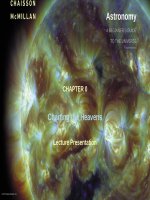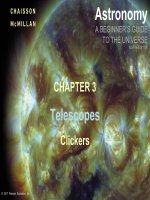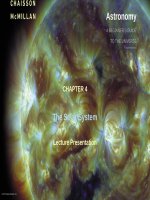Astronomy a beginners guide to the universe 8th CHaisson mcmillan chapter 12
Bạn đang xem bản rút gọn của tài liệu. Xem và tải ngay bản đầy đủ của tài liệu tại đây (3.45 MB, 43 trang )
Astronomy
A BEGINNER’S GUIDE
TO THE UNIVERSE
EIGHTH EDITION
CHAPTER 12
Stellar Evolution
Lecture Presentation
© 2017 Pearson Education, Inc.
Chapter 12 Stellar Evolution
© 2017 Pearson Education, Inc.
Units of Chapter 12
•
•
•
•
•
•
•
•
Leaving the Main Sequence
Evolution of a Sun-like Star
The Death of a Low-Mass Star
Evolution of Stars More Massive than the Sun
Supernova Explosions
Observing Stellar Evolution in Star Clusters
The Cycle of Stellar Evolution
Summary of Chapter 12
© 2017 Pearson Education, Inc.
12.1 Leaving the Main Sequence
•
During its stay on the main sequence, any
fluctuations in a star’s condition are quickly
restored; the star is in equilibrium.
© 2017 Pearson Education, Inc.
12.1 Leaving the Main Sequence
•
Eventually, as hydrogen in the core is consumed, the star begins to leave the main
sequence.
•
Its evolution from then on depends very much on the mass of the star:
–
–
Low-mass stars go quietly.
High-mass stars go out with a bang!
© 2017 Pearson Education, Inc.
12.2 Evolution of a Sun-like Star
•
Even while on the main sequence, the composition
of a star’s core is changing.
© 2017 Pearson Education, Inc.
12.2 Evolution of a Sun-like Star
•
As the fuel in the core is used up, the core contracts; when it is used up the core begins to
collapse.
•
Hydrogen begins to fuse outside the core.
© 2017 Pearson Education, Inc.
12.2 Evolution of a Sun-like Star
•
Stages of a star leaving the main sequence.
© 2017 Pearson Education, Inc.
12.2 Evolution of a Sun-like Star
•
Stage 9: The red giant branch:
–
–
–
As the core continues to shrink, the outer layers of the star expand and cool.
It is now a red giant, extending out as far as the orbit of Mercury.
Despite its cooler temperature, its luminosity increases enormously due to its large size.
© 2017 Pearson Education, Inc.
12.2 Evolution of a Sun-like Star
•
The red giant stage on the H–R diagram
© 2017 Pearson Education, Inc.
12.2 Evolution of a Sun-like Star
•
•
Stage 10: Helium fusion
Once the core temperature has risen to
100,000,000 K, the helium in the core starts to fuse.
•
The helium flash:
–
Helium begins to fuse extremely rapidly; within hours the enormous energy output is over, and
the star once again reaches equilibrium.
© 2017 Pearson Education, Inc.
12.2 Evolution of a Sun-like Star
•
Stage 10 on the H–R diagram
© 2017 Pearson Education, Inc.
12.2 Evolution of a Sun-like Star
•
Stage 11: Back to the giant branch:
–
As the helium in the core fuses to
carbon and oxygen, the core becomes
hotter and hotter, and the helium burns
faster and faster.
–
The star is now similar to its condition
just as it left the main sequence, except
now there are two shells.
© 2017 Pearson Education, Inc.
12.2 Evolution of a Sun-like Star
•
The star has become a red giant for the
second time.
© 2017 Pearson Education, Inc.
12.3 The Death of a Low-Mass Star
•
•
This graphic shows the entire evolution of a Sun-like star.
Such stars never become hot enough for fusion past oxygen to take place.
© 2017 Pearson Education, Inc.
12.3 The Death of a Low-Mass Star
•
There is no more outward fusion pressure being generated
in the core, which continues to contract.
•
Stage 12: The outer layers of the star expand to form a
planetary nebula.
© 2017 Pearson Education, Inc.
12.3 The Death of a Low-Mass Star
•
The star now has two parts:
–
–
•
A small, extremely dense carbon core
An envelope about the size of our solar system.
The envelope is called a planetary nebula, even though it has nothing to do with planets—
early astronomers viewing the fuzzy envelope thought it resembled a planetary system.
© 2017 Pearson Education, Inc.
12.3 The Death of a Low-Mass Star
•
Stages 13 and 14: White and black
dwarfs:
–
Once the nebula has gone, the remaining
core is extremely dense and extremely
hot, but quite small.
–
It is luminous only due to its high
temperature.
© 2017 Pearson Education, Inc.
12.3 The Death of a Low-Mass Star
•
The small star Sirius B is a white dwarf
companion of the much larger and
brighter Sirius A.
© 2017 Pearson Education, Inc.
12.3 The Death of a Low-Mass Star
•
The Hubble Space Telescope has detected white dwarf stars in globular clusters.
© 2017 Pearson Education, Inc.
12.3 The Death of a Low-Mass Star
•
As the white dwarf cools, its size does not change significantly; it simply gets dimmer and
dimmer, and finally ceases to glow.
© 2017 Pearson Education, Inc.
12.3 The Death of a Low-Mass Star
•
A nova is a star that flares up very suddenly and then
returns slowly to its former luminosity.
© 2017 Pearson Education, Inc.
12.3 The Death of a Low-Mass Star
•
A white dwarf that is part of a semidetached binary system can undergo repeated novas.
© 2017 Pearson Education, Inc.
12.3 The Death of a Low-Mass Star
•
•
Material falls onto the white dwarf from its main-sequence companion.
When enough material has accreted, fusion can reignite very suddenly, burning off the
new material.
•
Material keeps being transferred to the white dwarf, and the process repeats.
© 2017 Pearson Education, Inc.
12.4 Evolution of Stars More Massive than the Sun
•
It can be seen from this H–R diagram
that stars more massive than the Sun
follow very different paths when leaving
the main sequence.
© 2017 Pearson Education, Inc.









